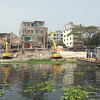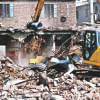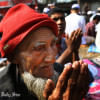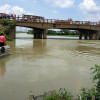The biggest wetland in Dhaka nobody knows about

On the west of Dhaka, once connected to Turag River but now separated by the western embankment or the Mirpur "beribadh," is Dhaka's largest wetland. That no one knows about! That remains invisible to the public consciousness! The wetland remains without a name and without any special identity in official reckoning. Yet this vast stretch of water body is a priceless asset at many levels and the last remaining endangered wetland in Dhaka city.
Before the construction of the beribadh in the early 1990s, the nameless water body was part of the overflow zone of the river; it was a floodplain. The construction of the embankment detached it from the river and its flows, and turned it into an unsuspecting wetland, a terra-aqueous zone. Now this organic shaped wetland, more of a lake, to the north of the Botanical Garden is framed by the beribadh to the left, a canal (Digun Khal) to the east and south, and RAJUK's new housing to the north. With an area of nearly 700 acres, the wetland is a little smaller than the Maidan in Kolkata and Central Park in New York, and significantly larger than Hatirjheel.
No one knows about this "water body" because it cannot be viewed from any vantage point to get a glimpse of its immensity. And it certainly cannot be accessed for any public experience. Increasingly encircled by installations, mostly governmental, it is made to be invisible. The only way to view the wetland and comprehend its vastness is on Google Maps. Even on maps, it remains largely unrecognised. In a map for ecologically sensitive areas in Dhaka's Detailed Area Plan (DAP) 2022-25, this western wetland is not even noted, although there is a vague marker for "Goran-Chotbari Water Park" in that document, and a Mirpur Lake in an imprecise Google map. One wonders if there is a wilful or planned abandonment of this magnificent wetland. Perhaps, it is a planning tactic for questionable operations? Reviewing timeline maps, one can see clearly the incremental landfill on the wetland from almost all sides. The most recent is on the north side that has filled up 36 acres of the wetland for a supposed resettlement project by a government agency.
The fate of this wetland with no name is symptomatic of the vast destruction of Dhaka's precious ecological resources—canals, wetlands, ponds, forests—in the name of urban development. If there is one axiomatic fact about Dhaka, it is that it is being built on the ruin of its ecological and natural assets. The destruction is both deliberate and wanton, and one is inclined to think, planned. Despite strong laws on preserving such areas, various state agencies have been complicit in the devastation, along with the happy partnership of private entities. No wonder we have the least livable city on the planet.
ANIMATION: SANJOY ROY/BENGAL INSTITUTE
The scale of destruction in the making of Dhaka baffles the imagination. In 2019, Arfar Razi, a geographer at Bengal Institute, calculated that the amount of landfilling needed for the Purbachal-Bashundhara area between 1975-2018 was near 16 billion cu ft. That volume of landfill/sandfill would be enough to fill up the Buriganga River from Gabtoli point all the way to the Meghna River. What gigantic earth-moving operations by both the state and private operators to build a city over a destroyed water ecology! If only more hydrologically sensitive approaches were made, then economic drives would have matched ecological imperatives, and then Dhaka would have received a more balanced and appropriate urbanity.
To give recognition to our vast wetland on the Turag and to extract it from a generic existence in official documents, the first task would be to name it. In the 1780 map of Dhaka and its environs by the colonial cartographer James Rennell, present Turag river is named as "Sarvarya" or "Cassimpour" (on his map, Rennell even identifies a flood flow zone for the Turag). We can assume for now that Sarvarya may have referred to a sarovar, or lake, that is, the immense watery condition that prevails on the western side of Turag even now during monsoon. Echoing that assumption, and in recognition of a sarovar, we can suggest calling Dhaka's western wetland "Sharoboriya."
It is worthwhile to review some important facts about this wetland. Presently covering a total area of 610 acres (down from 780 acres in 2010), the water capacity of the wetland is about 5.5 million cubic meters. Even in its present capacity, this entire wetland is working as a vast water retention area for Dhaka, particularly for the greater Mirpur area. Our own mapping of the watershed and flow pattern shows that a huge portion of surface water runoff is occurring, following a path from the Mirpur 14 area to a northern direction and falling into this wetland. It is clear that this particular wetland has a considerable impact, both direct and indirect, on the entire Mirpur area for about two million people living there.
Now what to do with this Sharoboriya, the largest wetland in metropolitan Dhaka? The immediate task would be to retain the ecological and hydrological properties of this lake and also open it up for public experience. The western wetland can be a part of Dhaka's enhanced urban life in terms of retaining and draining of water, providing key biodiversity, cooling air temperature, absorbing air pollution, and offering an astounding landscape and a dearly needed public space to the city. In the DAP 2022-25 document, there is a plethora of proposed water parks for all over the city, including the west wetland, but it is never clear what those are. The proposition is vague with no clear definition of what a water park is, what its perimeters are, and no precise direction on preserving the hydrological properties of the wetland and its specific ecological values for Dhaka.

Besides naming, we propose an immediate definition of the boundary of the wetland so that no further encroachments happen. Environmental laws or barbed wire fences are not enough to protect a special area; an appropriate usage of the boundary condition, however, can. We suggest making the whole periphery porous as a defined public zone. Stretching for a total linear length of 2.6 km, the bounded zone can simply be a belt park around the wetland in which the public can have open and free access. Then, selected access to the wetland itself can be designed for an enhanced experience.
Bordering the embankment road on the western side of the wetland and now being occupied by various entities is a strip of land of an area of about 22 acres. Those occupying that strip will have to cede it to the public park project. Even if completed on this strip, the greatest public space can be organised there for a city that dearly lacks public spaces. If just planted with trees, the area can have the biggest forest in Dhaka, with additional benefits if linked to the Botanical Garden to the south.
In considering the transformation of this wetland/lake, I have in mind two examples, both from the city of Hangzhou in China: the West Lake and the Xixi Wetland Park. Interested readers may look them up online. Urban and national treasures at the same time, but both undergoing decay and abuse at certain periods, the West Lake and Xixi Park received major restoration treatment by Chinese authorities. The two areas eventually became prosperous hydrological domains and massively popular public spaces. The western wetland in Dhaka, Sharoboriya, holds up a similar promise.
Kazi Khaleed Ashraf is an architect and writer, and directs the Bengal Institute for Architecture, Landscapes and Settlements. The article was developed with inputs from Sanjoy Roy, Arfar Razi, Nusrat Sumaiya and Hassan Rakib.
Views expressed in this article are the author's own.
Follow The Daily Star Opinion on Facebook for the latest opinions, commentaries and analyses by experts and professionals. To contribute your article or letter to The Daily Star Opinion, see our guidelines for submission.

 For all latest news, follow The Daily Star's Google News channel.
For all latest news, follow The Daily Star's Google News channel. 










Comments